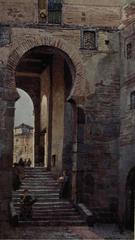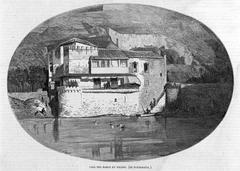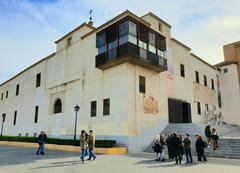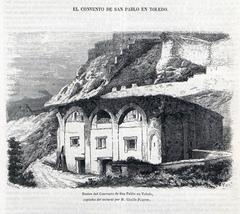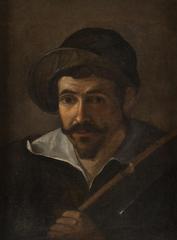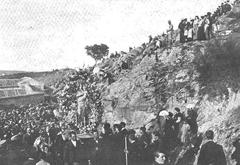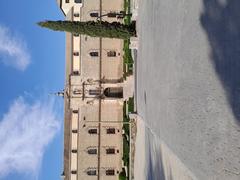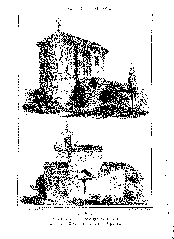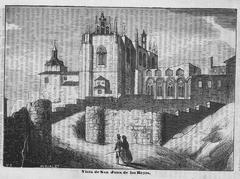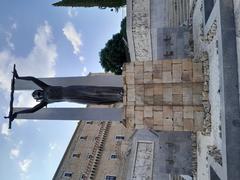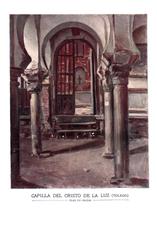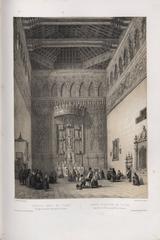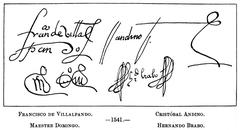
Church of Santa Leocadia, Toledo: Visiting Hours, Tickets, and Historical Significance
Date: 04/07/2025
Introduction
Nestled in the heart of Toledo, Spain, the Church of Santa Leocadia stands as a powerful symbol of the city’s rich religious and cultural heritage. Dedicated to Saint Leocadia—a revered Christian martyr and Toledo’s patron saint—this church is a focal point for pilgrims, history enthusiasts, and travelers seeking to experience the spiritual and architectural splendor of medieval Spain. Built on the saint’s traditional birthplace, the church has been a center of worship, devotion, and artistic expression since at least the 12th century. Its unique Mudéjar architecture, layered history, and ongoing religious significance make it an essential stop for any visitor exploring Toledo’s “City of Three Cultures” (cultura.castillalamancha.es; toledoguiaturisticaycultural.com).
This guide offers a comprehensive overview of the Church of Santa Leocadia, detailing its origins, artistic features, practical visitor information, and its place within Toledo’s sacred landscape.
Table of Contents
- Historical Overview
- Artistic and Architectural Highlights
- Visitor Information
- Rituals, Festivals, and Community Life
- Nearby Attractions
- Frequently Asked Questions (FAQ)
- Plan Your Visit
- Summary and Final Tips
- References
Historical Overview
Origins and Early History
The Church of Santa Leocadia marks the birthplace of Saint Leocadia, a noblewoman martyred during the Diocletianic Persecution in the early 4th century. Her unwavering faith made her a central figure in Toledo’s Christian tradition. The site became a place of pilgrimage and veneration, with documentary evidence dating the parish to the 12th century, known as “Santa Leocadia de dentro de Toledo” (cultura.castillalamancha.es; catholicsaints.day).
A small crypt, covered by a ribbed plaster vault and located near the presbytery, is believed to be the saint’s oratory. The church’s continued association with the saint has made it a site of devotion through the centuries (es.wikipedia.org).
Architectural Evolution
Santa Leocadia’s architecture embodies Toledo’s history of cultural convergence. The church is a prime example of the Mudéjar style, blending Islamic decorative elements with Christian liturgical design—a hallmark of Toledan architecture after the Reconquista. The present structure mainly dates from the late 13th century, with significant renovations in the Renaissance and neoclassical periods. Notable contributors include Juan Bautista Monegro (16th century) and Ignacio Haan (18th century), whose altarpiece features sculptures by José Antonio Vinacer (dialnet.unirioja.es).
Religious and Cultural Significance
Saint Leocadia’s cult has shaped Toledo’s religious landscape since the Visigothic era. Her feast day on December 9 remains a major event, featuring special Masses and processions that emphasize the church’s living role in Toledo’s spiritual life (catholicsaints.day; tradcatholica.com).
Artistic and Architectural Highlights
The Mudéjar Tower
The Mudéjar tower, adjoining the church’s apse, is its most striking feature. Built in the 13th century, the tower reflects Islamic minaret designs, with alternating courses of masonry and brick, narrow windows topped by lobed arches, and a frieze of blind arches with intricate plasterwork. The belfry features paired horseshoe arches, and the cornice is supported by projecting bricks—a nod to caliphal corbels. This tower is a testament to Toledo’s unique blend of Islamic and Christian influences (es.wikipedia.org).
Image: Mudéjar tower of the Church of Santa Leocadia Toledo with intricate brick and plaster arches.
Visigothic Remnants and the Crypt
Embedded in the tower and façade are rare Visigothic reliefs—tangible remnants of Toledo’s pre-Islamic Christian past. The crypt, believed to be Saint Leocadia’s oratory, is accessible from the presbytery and offers a contemplative space for visitors interested in early Christian history.
Image: Ribbed plaster vault of the crypt in Church of Santa Leocadia Toledo.
Artistic Heritage
Inside, the neoclassical main altarpiece designed by Ignacio Haan is a highlight, featuring a 1616 painting by Eugenio Cajés depicting Saint Leocadia as Toledo’s protector. This artistic ensemble, alongside other devotional artworks, underscores the church’s ongoing cultural and spiritual importance (dialnet.unirioja.es).
Visitor Information
Visiting Hours
- Weekdays: 10:00 AM – 1:30 PM and 4:00 PM – 7:00 PM
- Sundays and Public Holidays: 11:00 AM – 4:00 PM
Note: Hours may vary during religious services and festivals. Check ahead for seasonal changes or special events (toledo-travelguide.com).
Tickets and Admission
- Admission: Typically free; donations are welcomed to support maintenance.
- Tourist Bracelet: For €14, the “Pulsera Turística” gives access to seven principal monuments (Santa Leocadia may not always be included; confirm at purchase) (lionsinthepiazza.com).
Accessibility
- The church is wheelchair accessible at the entrance, but the crypt is only reachable by stairs and may not be suitable for visitors with mobility challenges.
- Assistance can be arranged through the parish or local tourist offices.
Guided Tours
- Guided tours in English and Spanish are available; booking ahead is recommended, especially during peak seasons. Many city walking tours include Santa Leocadia and provide invaluable historical context (madridtraveling.com).
Visitor Tips
- Wear comfortable shoes—Toledo’s streets are cobblestoned and hilly.
- Dress modestly (shoulders and knees covered).
- Photography is generally permitted, but avoid flash and respect restrictions during services.
- Visit early to avoid crowds and enjoy the church’s atmosphere.
Rituals, Festivals, and Community Life
Feast of Saint Leocadia
On December 9, the church celebrates its patron saint’s feast day with special Masses, processions, and community events—a unique opportunity to experience Toledo’s living Catholic tradition (toledoguiaturisticaycultural.com).
Local Traditions
Santa Leocadia participates in major religious festivals, including Holy Week, reinforcing its role as a center of community life.
Nearby Attractions
- Convent of Santo Domingo el Antiguo: Home to El Greco’s early masterpieces.
- Toledo Cathedral: The city’s iconic Gothic cathedral.
- Alcázar of Toledo: A historic fortress with panoramic city views (toledospain.click).
- Ermita del Cristo de la Vega: Site of Saint Leocadia’s burial, outside the city walls.
Combine Santa Leocadia with these landmarks for a full day exploring Toledo’s religious and artistic heritage.
Frequently Asked Questions (FAQ)
Q: What are the Church of Santa Leocadia’s visiting hours?
A: Generally, 10:00 AM to 1:30 PM and 4:00 PM to 7:00 PM on weekdays; Sundays and public holidays 11:00 AM to 4:00 PM. Hours may change during religious events.
Q: Is there an admission fee?
A: Entry is free, but donations are encouraged.
Q: Is the church wheelchair accessible?
A: Partial accessibility—entrance is accessible, but the crypt is not.
Q: Are guided tours available?
A: Yes, bookable in advance or as part of city tours.
Q: Can I take photos inside?
A: Yes, but without flash and always respect service times.
Q: How do I reach the church?
A: It’s located in Toledo’s historic center—best reached on foot.
Plan Your Visit
- Check the official Toledo tourism site or parish pages before you go.
- For more detailed guides and walking tours, download the Audiala app.
- Explore related articles on the Toledo Cathedral, Monastery of San Juan de los Reyes, and other Mudéjar churches.
- Visit local tourist information centers for maps and event updates (toledo-travelguide.com).
Summary and Final Tips
The Church of Santa Leocadia is a vital piece of Toledo’s living history. From its foundations as the saint’s birthplace and oratory to its architectural evolution across centuries, the church embodies the spirit of religious endurance and cultural fusion. Its Mudéjar tower, Visigothic fragments, and evocative crypt create a unique atmosphere for reflection and discovery. Attending the feast day celebrations or exploring the church’s art and architecture is a memorable way to connect with Toledo’s heritage (es.wikipedia.org; lionsinthepiazza.com).
For a fulfilling visit, plan ahead, observe respectful behavior, and consider exploring nearby historical sites to gain a broader understanding of Toledo’s sacred geography (toledo-travelguide.com; madridtraveling.com). Use official resources and guided tours for an enriched experience. The Church of Santa Leocadia is not just an architectural gem—it’s a living testament to Toledo’s spiritual and cultural legacy (cultura.castillalamancha.es; toledoguiaturisticaycultural.com).
References and Further Reading
- Church of Santa Leocadia Toledo: Visiting Hours, Tickets & Historical Guide
- Visiting Santa Leocadia Church in Toledo: Hours, Tickets & Historical Guide
- Church of Santa Leocadia Toledo: Visiting Hours, Tickets, and Historical Highlights
- Artistic Heritage and Conservation
- The Church in Toledo’s Sacred Landscape
- Visiting Santa Leocadia Church in Toledo: Hours, Tickets & Historical Guide
- Rituals and Community Life
- Toledo Travel Guide
- Churches in Toledo Spain





